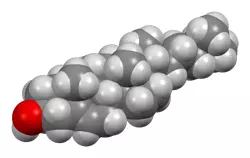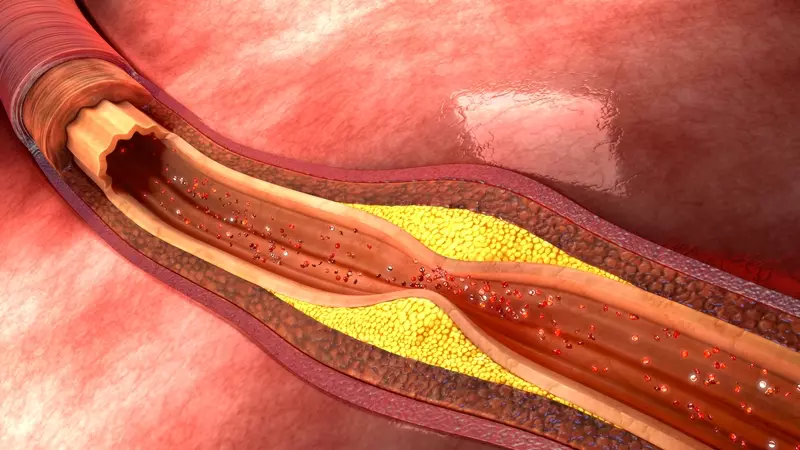
Today, I want to talk about something that’s been on my mind lately – cholesterol and atherosclerosis. We’ve all heard about cholesterol, right? And we know it can be bad for our health. But did you know that cholesterol is present in every human body, and it’s completely normal? Yet, we’re all at risk of developing atherosclerosis. So, let’s dive in and see how much our diet and the fat content in our food really affect our cholesterol levels and atherosclerosis.
There’s a common myth that a fatty and improper diet leads to increased cholesterol levels and the development of atherosclerosis. However, research shows that this is not the case. The direct link between the amount of cholesterol in food and its concentration in the blood has not been proven. On the contrary, it has been repeatedly proven that the cholesterol from food and the cholesterol accumulating in atherosclerotic plaques are two completely different cholesterols. There are data from experiments on healthy volunteers who consumed large doses of cholesterol for several months. None of them showed an increase in blood cholesterol levels or signs of atherosclerosis.
Moreover, atherosclerosis is widespread in several developing countries where the population is undernourished and starving. In cases of starvation or an inadequate, low-protein diet combined with physical overloads and emotional stress, atherosclerosis develops extremely quickly. This was known even before the cholesterol boom – from the autopsy results of thousands of corpses of prisoners of fascist concentration camps. Even among young prisoners, emaciated and not receiving cholesterol with food for several years, severe atherosclerosis was registered.
Comparing data on food consumption in different countries and the prevalence of cardiovascular diseases, it is impossible to establish a correlation between the type of diet, the amount of animal products, and the level of cardiovascular diseases. Therefore, it is worth thinking and researching this topic deeper to avoid misinformation, which often leads to the spread of various myths about cholesterol, diets, and drugs.
Contrary to popular belief, a new review of studies conducted by an international team of doctors and published in the Expert Review of Clinical Pharmacology journal in 2018, questions whether “bad” cholesterol, or low-density lipoproteins (LDL), is the cause of cardiovascular diseases.
Cardiologists from various countries, including the USA, Sweden, the UK, Italy, Ireland, France, and Japan, found no evidence of a link between high levels of total or “bad” cholesterol and cardiovascular diseases. After analyzing data from 1.3 million patients, they asserted that this notion is based on uninformative statistics and the exclusion of contradictory observations.
In other words, we may have been misled and deceived about cholesterol. The sources of this misconception are incomplete statistical data and the disregard of conflicting observations.
Therefore, as of 2023, we see no connection between “good” and “bad” cholesterol and cardiovascular diseases. The body itself is capable of regulating cholesterol levels, and it performs this necessary function without external intervention. Cholesterol plays a crucial role in the body as it is a building block for cell membranes, necessary for the production of vitamin D and hormones such as testosterone and estrogen. Moreover, two-thirds of the body’s cholesterol is produced by the liver.
Thus, it’s worth considering that we may have been deceived and scared about cholesterol. Instead of viewing it as something bad, we should recognize that it performs essential functions in the body, and our body is capable of regulating its level.
So, regardless of how much we try to lower cholesterol levels or combat it through diets, the body will still produce it. Cholesterol is an integral and necessary substance for the body. Now, the question arises: if cholesterol is so beneficial and natural, why can it lead to clogged vessels and the formation of atherosclerotic plaques?
Let’s delve into the mechanism of this process. Consider, for example, a cross-section of an artery. An artery is a muscular organ, essentially a tube with a thick wall. This mechanism can be particularly well observed in the case of large arteries, such as the abdominal aorta or the aortic arch. The thick wall of the artery requires nourishment through microscopic vessels, known as vasa vasorum.
During a stressful situation, when we need to run or fight, blood is concentrated where it’s most needed – in the muscles and lungs, to ensure effective movement and combat. Organs not directly involved in this activity, including the liver, gallbladder, stomach, intestines, and even the brain, do not require blood. These organs begin to receive reduced blood supply as blood is redirected to the periphery, where it’s needed for the muscles.
This mechanism has evolved to provide the body with maximum efficiency in stress and danger situations. It operates very quickly and allows the concentration of blood and energy where they are most needed.
However, when the stressful situation is resolved, for example, if the prey has escaped (or has been eaten), the conflict disappears, and the body relaxes. The vessels dilate, circulation returns to normal, and the organs once again receive adequate blood supply.
Now let’s connect this with the formation of atherosclerotic plaques. When stress persists for a long time, for example, due to chronic stress or an unhealthy lifestyle, the vessels remain spasmodic or narrowed, leading to disruption of normal blood flow. This can lead to damage to the inner layer of the arteries (endothelium) and accumulation of cholesterol at the sites of damage. Thus, atherosclerotic plaques are formed, which can narrow the artery’s lumen and hinder normal blood flow.
It’s important to understand that cholesterol itself is not the enemy. The problem lies in the disruption of balance, prolonged stress, and dysfunction of the vessels. Therefore, maintaining a healthy lifestyle, including a balanced diet, physical activity, and stress management, plays a crucial role in maintaining vascular health and preventing atherosclerosis.
The issue with the human body is that we have a brain that can continually revisit the same problems and stresses, making them chronic. As a result, our vessels, particularly the central and large ones, remain in a constant state of spasm.
Vessels have a wall that should relax and contract as needed, according to nature’s design. But due to constant spasm, the vessel wall remains constricted and doesn’t relax as it should.
As a result, plasma begins to be squeezed out from the capillaries, as they are not designed for constant compression. This can lead to the layering and delamination of the vessel, which is already a dangerous situation. If we look at the vessel wall under a microscope, we’ll see that it consists of cells that are interconnected.
And here’s the question: what are these connections between cells made of? The correct answer is cholesterol. Due to constant chronic stress, blood tries to tear the vessel wall and break through these connections. The body, not allowing this to happen, reflexively starts to reinforce these connections, driving more cholesterol into this area.
Thus, the vessel wall begins to be clogged with cholesterol. This happens not because we eat a lot of pork or frequent fast-food joints (although that’s not good either). The root cause lies in our head – chronic stress causes atherosclerosis. It’s important to understand that cholesterol itself is not the cause of problems. The problem is related to the disruption of balance, prolonged stress, and dysfunction of the vessels. Therefore, stress management and maintaining a healthy lifestyle are key factors in preventing atherosclerosis and maintaining vascular health.
Thus, the process of atherosclerosis can be broken down into three stages: spasm, sclerosis (or fibrosis), and vessel reinforcement. The body employs various mechanisms to strengthen the vessels, making them even more robust and reliable.
The third stage of atherosclerosis development is called calcinosis. In this phase, calcium ions begin to deposit in the vessel wall, and it practically turns into a rigid structure, similar to bone. This process is called calcinosis. The body tries to repair this wall, and for this, it uses cholesterol, which serves as the “building materials.”
Chronic stress, which directly affects the arteries, is caused by devaluation. First and foremost, one should not berate and condemn oneself. Self-criticism and devaluation conflicts can cause vessel destruction, up to the formation of an aneurysm.
Another important mechanism is related to the presence of chronic inflammation in the body. In the case of chronic inflammation, whether it’s the gums, teeth, tonsils, sinuses, joints, kidneys, or liver, building material is needed for repair. Therefore, the cholesterol level increases until the inflammation subsides.
Cholesterol is like bricks and plaster; it’s building material. If there’s some prolonged repair going on in a person’s body, meaning there’s some chronic inflammation, then building materials are always needed. Hence, the cholesterol level will be elevated until the inflammation subsides.

For example, if a person has chronic inflammation of the gums or teeth, or tonsils, or sinuses, or joints, or kidneys, or liver – it doesn’t matter what, somewhere in the body there is one or several foci of chronic inflammation. Building materials are needed there, as there’s a massive construction going on. Therefore, the workers on this construction site will be carrying bags of bricks, bags of plaster day after day. Naturally, they will litter along the way, and traces of these building materials will remain. This litter is what we see in the blood test. This is the very elevated cholesterol that doctors fight against. The question is: there’s construction here, a house needs to be finished, it needs to be repaired. Is there any sense in taking away the building materials from the workers so they don’t litter? What’s the point in that?
The logic is as follows: let’s pump a person full of statins, knock out all their cholesterol, so there’s no cholesterol here and it’s all clean. And the person starts taking statins. Statins are like building a fence around the construction site, away from the workers. That is, the purpose of these workers’ lives is to carry building materials to the construction site, to carry cholesterol there. Our building is not finished, it will continue to deteriorate. The body will still try to deliver this building material to the construction site, but we don’t allow it.
Statins are one of the most profitable categories of pharmaceuticals. They are expensive, deemed absolutely necessary by cardiologists, and are to be taken for life. It’s very convenient – simply scare everyone, tell them they need these pills, take them for life, or else a heart attack is guaranteed. It’s a perfect strategy.
Recent studies provide clear and convincing evidence that psychosocial factors contribute significantly to the pathogenesis and expression of coronary artery disease (CAD). This evidence is composed largely of data relating CAD risk to 5 specific psychosocial domains: (1) depression, (2) anxiety, (3) personality factors and character traits, (4) social isolation, and (5) chronic life stress.
https://doi.org/10.1161/01.cir.99.16.2192
However, even at the official level, new information is starting to seep through. Even Wikipedia now states that simply lowering cholesterol levels does not solve all vessel problems. In such a case, a lack of cholesterol can cause hemorrhages. Further study of the causes of vessel damage and the development of treatment methods is required.
Thus, the information is officially recognized, but it’s not yet widely disseminated. This is just the beginning, and further research should continue. So, it’s important to take your health into your own hands and figure out the situation independently.
So, we can make the following action plan if elevated cholesterol levels signal problems in the body:
- Deal with stressful situations and stop reacting dramatically to them.
- Get rid of self-devaluation.
- Eliminate chronic inflammation in the body.
- Normalize bile flow. Bile plays a role not only in digesting food but also in removing waste from the body.
- Normalize nutrition.
- Conduct a proper detox of the body.
If your cholesterol level doesn’t bother you, you may not need to take any additional actions. However, in any case, implementing the above points of the plan can positively affect the length and quality of your life.
I will try to discuss these points in more detail in the following articles.
Summary
Cholesterol and atherosclerosis are related, but not directly. Prolonged stress and imbalance in the body can lead to atherosclerosis. Stress management, a healthy lifestyle, and inflammation elimination are important for preventing atherosclerosis. Statins don’t solve all vessel problems; a comprehensive approach is required.
Disclaimer
The information provided in this article is for general informational purposes only. The content presented on this website should be considered solely as opinions and personal experiences. Read more

The article is certainly very bright, but I would listen to the story with a certain degree of skepticism. For example, the theory that all vessels (except those for muscles) constrict under stress. Then how to explain that in most cases atherosclerosis can be detected in the aorta, through which blood is directed to the entire body, including the muscles? And what about peripheral artery disease, when atherosclerosis mainly damages the vessels of the legs? In my opinion, you is too fond of advancing your own hypotheses. Although, regarding the fact that fat and cholesterol as such are not the main cause of sclerosis, I agree.
But, in my opinion, more than low self-esteem, this process depends on the intake of carbohydrates and too frequent food intake.
Thank you for your thoughtful feedback, Janis. Indeed, the physiology of blood vessels and the development of atherosclerosis are multifaceted processes that aren’t fully understood.
Regarding the constricting of blood vessels under stress, it’s a generalized statement and does not apply uniformly to all vessels. Certain factors, like the presence of atherosclerotic plaques, the type of vessel, and individual physiological responses, can all affect how vessels react to stress.
As for your question about atherosclerosis in the aorta and peripheral artery disease, you’re correct that these conditions seem to contradict the theory. Atherosclerosis can indeed be widespread and affect various types of arteries throughout the body, not just those in the heart or brain.